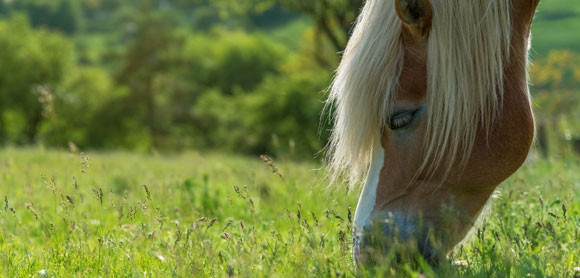
Spring pasture management: a guide for horse owners
After the long slog of winter, you can start to look forward to lighter evenings and warmer weather. While your paddocks might not look their best now, they’ll benefit from a spring pasture management plan to get them back on track and free from weeds so you can make the most of them this year.
Pasture management for horses
Good pasture management is key to keeping weeds down and making sure your horse has good-quality grazing all year round. Spring is a great opportunity to do some general maintenance that’ll help your fields recover after the winter.
We recommend considering the following:
- Harrowing
- Reseeding and rolling
- Soil analysis
- Fertilising
- Removing weeds and poisonous plants
Harrowing
Harrowing helps level uneven areas, removes weeds with shallow roots, aerates the soil and encourages grass growth while stripping away dead grass.
You should poo-pick your paddock before harrowing to avoid spreading parasitic larvae across the field.
Avoid harrowing near sycamore trees as this will spread the seeds, increasing the risk of sycamore poisoning and atypical myopathy.
Harrowing is considered a risk factor associated with grass sickness so you may want to avoid it for this reason.
Reseeding and rolling
Reseeding and then rolling any bare or poached areas can help maximise your usable pasture. Spring is the best time to reseed but you shouldn’t allow your horse back on a reseeded area until the new growth is five to six inches tall.
Soil analysis
Spring is one of the best times of year to carry out a soil analysis. Finding out the pH and nutrient levels is the first step towards working out if your pasture actually needs any horse paddock fertilisers adding.
Over-fertilising can cause excessive grass growth, which isn’t necessarily a positive thing if you have a good-doer or horse prone to laminitis. It’s advisable to speak to a professional before fertilising your pasture as you must comply with government guidelines and only fertilise at certain times of year.
Consider cross-grazing
If you have a lot of land and are friends with a local farmer, you could cross-graze your horse’s pasture with sheep or cattle. They both eat a lot of tough grasses and weeds that horses tend to avoid.
Sheep and cattle can also help to reduce the amount of rich grass available over the spring, which minimises the risks of your horse gaining excessive weight.
The lifecycle of equine parasites will be broken if they’re ingested by sheep or cattle. You’ll still need to keep your horse’s worming programme up to date, though. Make sure the sheep or cattle are regularly wormed, too.
Removing weeds and poisonous plants
You can remove weeds by hand, topping the pasture or treating with herbicides. Depending on what weeds and plants you’re trying to remove, it’s likely you’ll use a combination of methods.
Digging weeds out by hand can be hard work, so is only really feasible if you have a small pasture or a few weeds. Avoid leaving a pile of pulled weeds in your horse’s field as some plants, such as ragwort, become more palatable yet more toxic when dried. Here’s how you can spot poisonous plants and what to do about them.
Topping your pasture stops weeds going to seed by removing the head of the plant. This isn’t recommended for ragwort, however, as the tops will be left on the field. Remember that any perennial weeds will regrow.
Herbicides can help with a serious infestation of poisonous plants. Spot-spraying is the most effective way to treat docks and gorse. Purchase and application of herbicides is controlled so you’ll have to employ a professional contractor. They’ll be able to recommend the best product for your pasture and let you know how long to keep your horses off the land. For ragwort, it’s best to use herbicides at the rosette stage in the spring. The dead rosette must then be dug out.
Ragwort
Ragwort is a challenge you’re likely to face as a horse owner. This poisonous plant is common in the UK as it spreads easily but it causes damage to horses’ livers when ingested.
The easiest way to pull it out is to use a specially designed ragwort fork to remove the root. Doing this regularly before it flowers is the best way to keep on top of it if you have a fairly small area.
How to dispose of ragwort
Once you’ve pulled it out, it’s important to dispose of it as soon as possible, as the ragwort can seed even after you’ve removed it from the ground. You should seal the ragwort in a paper bag and either burn it in a controlled, safe manner, allow it to rot in a secure compost bin or employ a waste management company to dispose of it for you.
Sycamore saplings
Sycamore seeds are shaped like helicopters, which allow sycamore saplings to distribute them far and wide. While the scattering of these seeds usually occurs during autumn, the seedlings start growing in spring.
The seeds have a toxin in them which – when ingested by a horse – can cause a muscle disease known as Atypical Myopathy.
Sycamore poisoning in horses is very common, so you must remain vigilant in spotting any seedlings in your pasture. It’s best to fence off any areas where you have spotted these seeds until you have removed them and know it’s safe for your horse once again.
Share your pasture management tips with us on social media using #PethoodStories.



